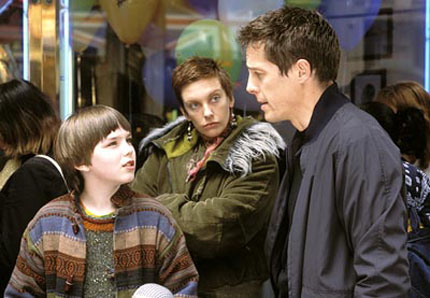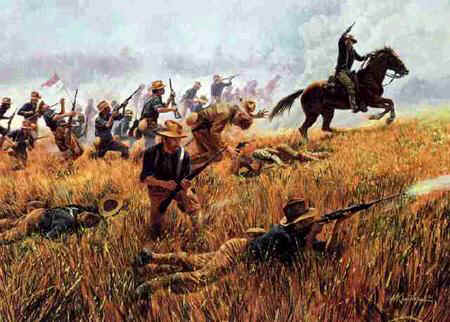Congrats to my beautiful wife, who gave a successful, brilliant talk the other night at Georgia Southern's Great Mind series. She's so intelligent and learned!
And, yep, a new month means 10 more selections to Charles' 200 Essential Films. Here's the latest crop:
About a Boy (2002, Chris Weitz, Paul Weitz)
A movie impossible to dislike, a note-perfect adaptation of Nick Hornby's novel, with Hugh Grant ideally cast as the lazy lothario who becomes a father figure to the bullied son of a wristcutter (Toni Collette). Funny, appealing as hell, with somber notes of truth, and a great climax involving a talent-show performance of Roberta Flack's "Killing Me Softly."
E.T. (1982, Steven Spielberg)
A great fable about friendship and the wonders of childhood, with timeless Spielbergian themes (absent parents, obsession, fantasy solace in wonder and fantasy) and indelible, eternal images (the bicycle across the moon, Reese's Pieces).
Holiday (1938, George Cukor)
From the play by Philip Barry comes the film version, and, as a vehicle for Kate Hepburn and Cary Grant, I think it's even better than the same year's Bringing Up Baby. Priceless, intelligent dialogue is abundant throughout, but it's the touching give-and-take connection between Grant, as a man who wants to take time off from his career, from the rat race, and, as the sister of Grant's fiancee and the only one who really, truly believes in him, Hepburn.
Invasion of the Body Snatchers (1956; Don Siegel
and
1978; Philip Kaufman)
My pick for the best film-and-remake tandem in sci-fi history. The original was a dastardly good parable (from Jack Finney's story) about McCarthyism and the blandness of American relationships. The equally sinister, terrifying remake was set in a free-love San Francisco, with Kaufman's rolling camerawork and a beautiful performance by Donald Sutherland as a Health Inspection bureaucrat who comes to the realization that his colleagues are acting very, very hollow. Heck, even the 1994 and 2007 remakes were decent!
Jaws (1975, Steven Spielberg)
John Williams' ominous, foreboding score. Robert Shaw's nearly on-the-spot tale of the fate of the USS Indianapolis sailors. The woman clinging to the buoy in the opening moonlight. Roy Scheider hanging onto the mast of the sinking ship. Oh, yeah - "You're gonna need a bigger boat," too.
Nashville (1975, Robert Altman)
A one-of-a-kind Altman panorama of a group of hangers-on and others in the country music business: Lily Tomlin, Keith Carradine, Henry Gibson (in one of his only non-creepy-dwarf roles), Ned Beatty, Jeff Goldblum, Ronee Blakley, Scott Glenn - done in typical, influential Altman fashion - which means you'll either love it or hate it.
Short Cuts (1993, Robert Altman)
Altman meets the stories of Raymond Carver - which means you're going to get a menagerie of rambunctious, boozy, dour, uniquely Californian denizens - Lily Tomlin, Tom Waits, Robert Downey Jr., Madeleine Stowe, Lyle Lovett, Chris Penn, Fred Ward, Matthew Modine, Jack Lemmon, Julianne Moore - in what I think is Altman's finest achievement. It is very much a director's film all the way.
Taxi Driver (1976, Martin Scorsese)
"You talkin' to me?"
Up (2009, Pete Docter, Bob Peterson)
There's nothing as poignantly adult that has emerged from the Disney/Pixar wizards - perhaps outside of the death of the Bambi's momma - as the four-minute montage detailing the death of Carl's wife and the aftermath of his grief.
Moving on in our quest for 100 influential photographers:
Chuck Close (#31)
The Wisconsin-born Close (b. 1940) attended the University of Washington and Yale. He is a master photographer, painter, and printmaker.
Here's more about him:
http://www.artsconnected.org/artsnetmn/identity/close.html (This is a better summary of his technique, style, influences than I could give.)
His grid techniques are legendary in the field of Photorealism. He suffers from face blindness, Prospoagnosia - he is unable to recognize faces.
 |
| composer Philip Glass |
 |
| Monsieur Pitt |
History
Today, let's take a brief look at the Spanish-American War of 1898.
What started it?
Well, officially it began when 266 Americans were killed in an explosion on the battleship USS Maine in Havana Harbor.
What did Havana have to do with it?
At the time, Cuba was ruled by Spain. Cubans, particularly the rebels within the country, wanted to be independent, free of Spain. There were no conclusive results as to what caused the explosion. Again: There is no evidence that Spain was actually behind this.
So why war?
"Yellow journalism" was rampant in the U.S. The American newspapers of Joseph Pulitzer (the New York World) and William Randolph Hearst (New York Journal) specialized in sensationalism,frenzied articles, intrigue, drama - and they egged on a jingoistic, pro-war nationalism. Readers started the cry "Remember the Maine!"
Who was the U.S. president at the time?
William McKinley.
When was war declared?
By Spain, April 24, 1898. By the U.S, one day later. Spain wasn't crazy about the U.S. supporting Cuban independence.
Where was the war fought?
On two fronts, in the Caribbean and in the Philippines (under Spanish rule)
What were the major battles?
In the Philippines - Manila Bay. The U.S., led by Commodore Dewey, decisively crushed the Spanish fleet and took control of the bay.
In Cuba - Battle of San Juan Hill. The U.S. (including Theodore Roosevelt's famed, near-legendary crew of volunteer cavalrymen known as the Rough Riders) trapped the Spanish and took control of Santiago.
When did the war end?
Pretty much after the U.S. took control of Santiago. Around July 17, 1898. It was only about a 3-month war or so.
What did the U.S. receive?
The Treaty of Paris (1898) gave the U.S. Guam, Puerto Rico, and (for $20 million) the Philippines. Spain renounced all claims to Cuba too. Five years later, Spain handed over the long-fought-for Guantanamo Bay to the U.S, which the U.S. still pays a yearly lease for.
Thanks:
http://www.history.com/news/2012/04/24/6-things-you-may-not-know-about-the-spanish-american-war/
http://www.history.com/topics/spanish-american-war





0 comments:
Post a Comment